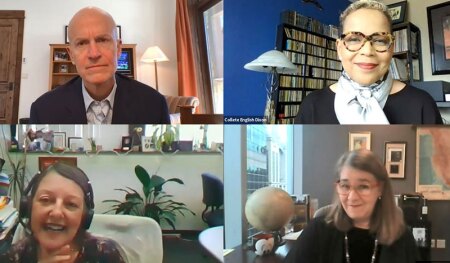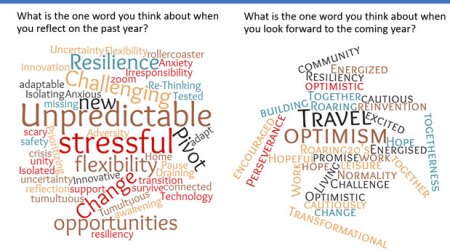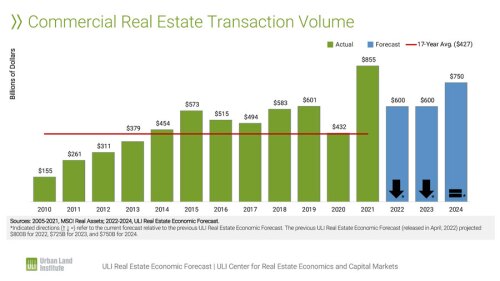While many businesses in the United States have been coping with the impact of the COVID-19 pandemic for a year or longer, the broader availability of vaccines and a rebounding global economy are cause for more optimism than skepticism across the real estate industry, said industry leaders participating in a recent webinar hosted by ULI’s Building Healthy Places Initiative. Industrial, self-storage, and single-family rentals have been some of the sectors surging, while laggard sectors are still betting on a burgeoning recovery.
Moderated by Collete English Dixon, executive director of the Marshall Bennett Institute of Real Estate at Roosevelt University in Chicago, the event featured observations from ULI Global Chairman Owen Thomas, chief executive officer of Boston Properties in New York City; ULI Trustee Mary Ludgin, senior managing director and director of global investment research for Heitman in Chicago; and Catherine Troisi, associate professor of management, policy, and community health and epidemiology at the University of Texas Health Science Center in Houston.
Dixon set up the discussion with an overview of how the health crisis, along with social upheaval and politically related events, laid the foundation for extended uncertainty: “In the spring [of 2020], the spread of the virus led to a lockdown that most people thought would be two weeks long—that we would flatten the curve by then. And, then [the United States] wound up going through a rocky summer, marked by social unrest, a fall defined by a virus resurgence, and a winter of drama following the election.”
A dramatic rise in U.S. unemployment—particularly during the second quarter of 2020—a worldwide recession, an increase in loans that had to go into special servicing and workouts, and a decrease in gross domestic product (GDP) all made for an economic environment ripe for improvement as COVID-19 is at least contained and vaccines become widely available, said Dixon.
Echoing some of the themes from Emerging Trends in Real Estate® 2021, Ludgin said that the pandemic appears to have accelerated many investment trends that were in place prior to the outbreak. Industrial, data centers, and single-family rentals have fared well, with occupier and tenant demand fundamentals remaining strong, she said. In particular, the light industrial and logistics sectors, which were already benefiting from a surge in online shopping, got a significant boost as stores closed in 2020. She also sees no upcoming weakness for these sectors, as post-pandemic online shopping is unlikely to decline.

Clockwise, starting in top right: moderator Collete English Dixon, executive director of the Marshall Bennett Institute of Real Estate at Roosevelt University in Chicago; ULI Global Chairman Owen Thomas, chief executive officer of Boston Properties in New York City; ULI Trustee Mary Ludgin, senior managing director and director of global investment research for Heitman in Chicago; and Catherine Troisi, associate professor of management, policy, and community health and epidemiology at the University of Texas Health Science Center in Houston, speaking on a recent ULI Building Health Places webinar.
Another sector that experienced a boost is self-storage, as both businesses and households placed furniture and goods in storage, Ludgin said. Self-storage is likely to remain popular as hybrid models for working and schooling continue to spark changes in space needs within offices and homes, she said. In addition, single-family rentals with multiple bedrooms and bathrooms—a sector that gained momentum last year—likely will continue to be popular, as more families seek homes with sufficient personal space to accommodate all household members, she predicted.
Despite numerous bankruptcies, liquidations, and cutbacks in stores throughout the retail sector, “retail is not dead yet,” Ludgin said partially in jest. Omnichannel retailers offering both online and in-person shopping were able to get through the pandemic by quickly shifting to a “buy online, pick up at store” business model that could remain a popular option post-COVID, she said. “The retailers that survived are those that are best able to meet the customer where customer wants to be met,” Ludgin said. However, the numerous retail casualties of the pandemic will result in significant repurposing of vacant space, she added.
Student housing rebounded quickly in the fall of 2020 as universities reopened, suggesting that this sector will remain strong, she said. In contrast, the outlook for senior housing is dim, she said, due to the severity of COVID-19 outbreaks in senior living facilities. While high vacancies in the sector will eventually decline, “meaningful reform is necessary,” said Ludgin.
Reflecting on the outlook for the office market, Thomas said that uncertainty in the sector is likely to remain until companies start forming and implementing clear return-to-work policies. “Everyone wants to call the ball in terms of the impact on office markets, but the truth is that no one knows the extent of the impact,” said Thomas, pointing out that the coastal gateway cities in which Boston Properties operates have yet to fully reopen. However, even though many offices are still mostly or partially empty, he said that office tenants have been continuing to pay rent. Particularly strong office properties include medical office and life science properties, he said.
“Usually during downturns, businesses are harmed, they have to lay off people, and they need less space. This time, they have added employees, and the question is how to use office space,” Thomas said. “I think companies will conclude that an important part of their success is getting employees back to the office and collaborating in person, and as a property owner, it is our job to help them do that by providing health security and great amenities. Easier commutes will also be key [in terms of office appeal].”
One key takeaway from the past 12 months has been the disruptive power of a pandemic, Thomas said. “In the future, there will be a tremendous focus on pandemics, and when we hear about a virus starting anywhere in the world, it will have a lot more impact on [real estate] markets going forward,” he said. In addition, he predicted that the recent federal stimulus package will help cities shore up COVID-related budget shortages and aid in quickening the overall economic recovery.
Troisi provided observations on how the COVID-19 pandemic will shape how future pandemics are addressed. One key learning in the United States is the need for better public health infrastructure—the nation has only 4.4 percent of the world’s population, but 25 percent of the COVID-19 cases and 20 percent of the deaths globally. “The mental health effects of this virus may last decades, including loneliness and fear, as well as the economic effects of the virus, particularly on lower-income people,” she said. “This is a new virus, but we are going to see more of them in the future, and we need to be ready to address them.”
The positive news, Troisi said, is that seven vaccines have been created and approved for use globally in an unprecedentedly short period of time, which is encouraging in terms of nations’ abilities to contain future viruses. The rapidly increasing vaccine availability in the United States—and the high efficacy of vaccines in the country—bodes well for reaching herd immunity, provided that 85 percent of the population is vaccinated, Troisi said. Reaching this goal entails overcoming vaccine hesitancy within certain segments of the population and debunking myths about harmful impacts, she added. “We are in a race between vaccinating people and keeping the virus [including variants] from getting ahead of us. We are making good progress, but we have to keep getting shots in arms.”
Both Ludgin and Thomas pointedly said that they were initially concerned that the health crisis would diminish climate change as a top priority but were relieved to see the issue remains at the forefront. Thomas cited U.S. President Biden administration’s focus on climate change as further elevating an issue that had already become increasingly important within the real estate investment arena. He noted that he was also pleased to see an increased emphasis within the business community in the areas of social and racial justice and diversity. “That is a big positive for businesses in general,” he said. “There is plenty more to do, but taking this to the next level is really important.”
A return to normalcy in terms of how people work, recreate, shop, and learn depends largely on human behavior—the willingness of people to keep following COVID safety protocols even as more restrictions are lifted, Troisi said. “We will be wearing masks for a while, but hopefully while we are doing things like traveling. In the end, this virus will probably never disappear. It’s in the population, and it’s unlikely to be eradicated. But hopefully, as is the case with the flu, we will be able to get vaccinated as often as necessary to protect ourselves and keep doing things we want to do.”
The webinar was the latest in a series of webinars hosted by the Building Healthy Places Initiative to help ULI members understand the role they can play in advancing health, social equity, and sustainability throughout the built environment. Access more of these sessions on-demand in Knowledge Finder.



